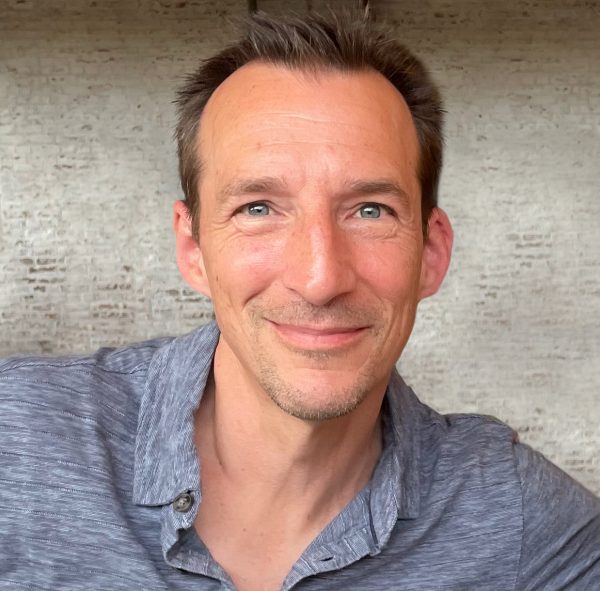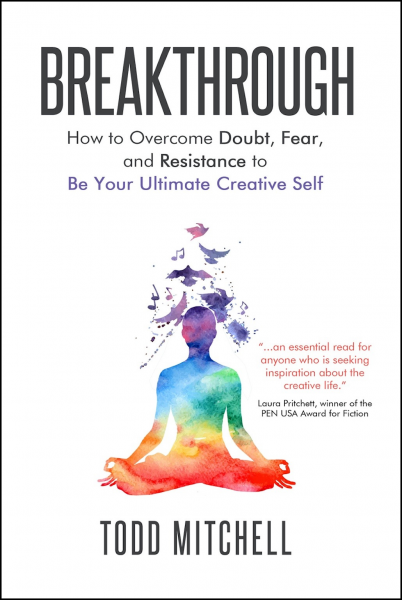“We tend to become creatively blocked when we start putting pressure on ourselves to create something “good,” or we start fearing what will happen if we create something “bad” that gets rejected or scorned. ” — Todd Mitchell
 This month, CSU’s Office of the Vice President for Research highlighted our own associate professor Todd Mitchell’s recent SunLit interview in The Colorado Sun as part of its monthly Research Review newsletter. In the interview, Mitchell discusses his writing process, researching creativity, and his debut nonfiction book that was nominated for a 2022 Colorado Book Award — Breakthrough: How to Overcome Doubt, Fear and Resistance to Be Your Ultimate Creative Self. Mitchell’s insightful interview sparked our own curiosity when it came to the connection between his discoveries about enhancing creativity and teaching writing in the English department.
This month, CSU’s Office of the Vice President for Research highlighted our own associate professor Todd Mitchell’s recent SunLit interview in The Colorado Sun as part of its monthly Research Review newsletter. In the interview, Mitchell discusses his writing process, researching creativity, and his debut nonfiction book that was nominated for a 2022 Colorado Book Award — Breakthrough: How to Overcome Doubt, Fear and Resistance to Be Your Ultimate Creative Self. Mitchell’s insightful interview sparked our own curiosity when it came to the connection between his discoveries about enhancing creativity and teaching writing in the English department.
As the Director of the Beginning Creative Writing Teaching Program, Mitchell offered us a window into how his own pedagogy has transformed and grown since penning his new book—take a look.
Interview with author and associate professor Todd Mitchell
CSU English: How has writing “Breakthrough” informed your teaching, specifically creative writing? Has your research on creativity changed the way you approach teaching craft?
TM: The things I learned while researching and writing Breakthrough dramatically changed my teaching and my life. I’ll be honest—I never expected to write a book like Breakthrough. It was only after I drove myself to a breakdown that I realized there had to be a better way to go about creating things. And there is. The techniques and approaches I gained from my research into creative practices completely shifted my relationship with creativity. It’s stuff I wish I’d known 25 years ago, and so, as a teacher, I try to save students years of agony by helping them develop healthy creative practices from the start. When we learn to engage creative endeavors openly and effectively, we open ourselves to life-changing possibilities.
 CSU English: What advice would you give your own students struggling to tap into creativity?
CSU English: What advice would you give your own students struggling to tap into creativity?
TM: First off, consider all the limiting beliefs and toxic myths that might be strangling your ability to connect with creativity. For instance, I often hear people say “I’m not very creative.” But creativity isn’t a fixed trait that you have or don’t have. Instead, it’s a skill that you can get better at. People who work on their creativity (or, to put it more accurately, people who develop practices that help them connect more effectively with creativity) can become more creative. And such increases in creativity can be measured in creativity tests. By the way, if you think that creativity isn’t an important skill to develop, some research has shown that scoring well on creativity tests is a greater predictor of future success than IQ scores and standardized test scores.
The second thing I’ll mention is that it’s important to reconnect with the joy of creativity. We tend to become creatively blocked when we start putting pressure on ourselves to create something “good,” or we start fearing what will happen if we create something “bad” that gets rejected or scorned. One way around such judgement-driven blocks is to allow yourself to create for the intrinsic enjoyment of creating.
Kids are often wildly creative because they allow themselves to have fun creating, and they celebrate what they create. Before attempting to create something, try to recall how enjoyable it can be to bring something new into existence. As you create, practice creative gratitude by celebrating even seemingly small creative acts. To quote Steve Martin, “I think I did pretty well, considering I started out with nothing but a bunch of blank paper.” Creating anything is an accomplishment. When we become more aware of the enjoyment of creativity, it makes it easier to keep creating.
CSU English: In the spring, you’re teaching a new course on reading and creating YA novels using a practitioner’s approach – tell us about it. Where did this course originate from? What do you hope your students gain from blending a critical lens with creative development?
TM: This is a dream course that I’ve always wanted to teach. In my experience as an author and a teacher, we learn best by doing. For instance, if you want to learn karate, reading about karate moves and hearing lectures on how to do it isn’t going to teach you much. But, if you combine such instruction with the practice of doing karate (and then get immediate feedback on your practice), you’re going to learn much more. The same goes for developing an understanding of stories and how to create effective narratives. Reading and discussing books alone isn’t enough. Taking a practitioner’s approach and attempting to plot, structure, and write a YA novel (while also reading and discussing YA novels) provides opportunities to learn much more about how to structure stories, engage readers, and transform characters. In addition, the skills and insights we gain from such hands-on learning has relevance well-beyond the English classroom. Afterall, when we’re writing a novel, we’re not just putting characters on a transformational journey. We’re transforming ourselves.

Todd Mitchell is an associate professor of creative writing at Colorado State University. He’s the author of six award-winning books, including The Last Panther (Penguin Random House), The Namer of Spirits (Owl Hollow Press), and Breakthrough: How to Overcome Doubt, Fear, and Resistance to Be Your Ultimate Creative Self (winner of the Nautilus Book Award).